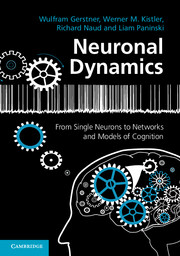Book contents
- Frontmatter
- Contents
- Preface
- PART ONE FOUNDATIONS OF NEURONAL DYNAMICS
- PART TWO GENERALIZED INTEGRATE-AND-FIRE NEURONS
- PART THREE NETWORKS OF NEURONS AND POPULATION ACTIVITY
- PART FOUR DYNAMICS OF COGNITION
- 16 Competing populations and decision making
- 17 Memory and attractor dynamics
- 18 Cortical field models for perception
- 19 Synaptic plasticity and learning
- 20 Outlook: dynamics in plastic networks
- References
- Index
19 - Synaptic plasticity and learning
Published online by Cambridge University Press: 05 August 2014
- Frontmatter
- Contents
- Preface
- PART ONE FOUNDATIONS OF NEURONAL DYNAMICS
- PART TWO GENERALIZED INTEGRATE-AND-FIRE NEURONS
- PART THREE NETWORKS OF NEURONS AND POPULATION ACTIVITY
- PART FOUR DYNAMICS OF COGNITION
- 16 Competing populations and decision making
- 17 Memory and attractor dynamics
- 18 Cortical field models for perception
- 19 Synaptic plasticity and learning
- 20 Outlook: dynamics in plastic networks
- References
- Index
Summary
In the network models discussed in Parts III and IV, each synapse has so far been characterized by a single constant parameter wij, called the synaptic weight, synaptic strength, or synaptic efficacy. If wij is constant, the amplitude of the response of a postsynaptic neuron i to the arrival of action potentials from a presynaptic neuron j should always be the same. Electrophysiological experiments, however, show that the response amplitude is not fixed but can change over time. In experimental neuroscience, changes of the synaptic strength are called synaptic plasticity.
Appropriate stimulation paradigms can induce changes of the postsynaptic response that last for hours or days. If the stimulation paradigm leads to a persistent increase of the synaptic efficacy, the effect is called long-term potentiation of synapses, or LTP for short. If the result is a decrease of the synaptic efficacy, it is called long-term depression (LTD). These persistent changes are thought to be the neuronal correlate of learning and memory. LTP and LTD are different from short-term synaptic plasticity such as synaptic facilitation or depression that we have encountered in Section 3.1. Facilitated or depressed synapses decay back to their normal strength within less than a few seconds, whereas, after an LTP or LTD protocol, synapses keep their new values for hours. The long-term storage of the new values is thought to be the basis of long-lasting memories.
- Type
- Chapter
- Information
- Neuronal DynamicsFrom Single Neurons to Networks and Models of Cognition, pp. 491 - 523Publisher: Cambridge University PressPrint publication year: 2014
- 1
- Cited by



